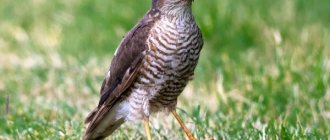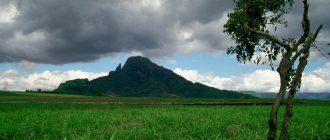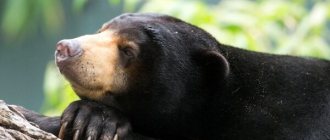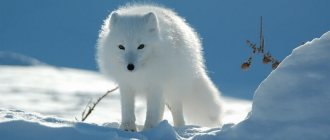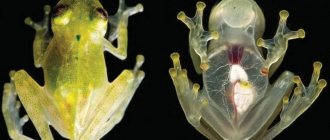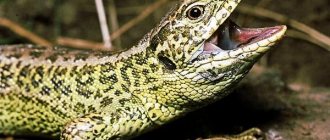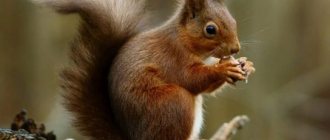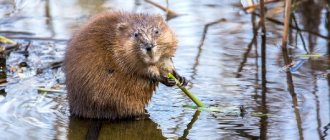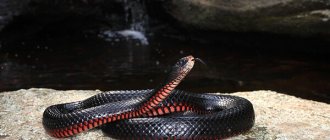Types of crossbill
The common crossbill is a forest song nomadic bird. Males are characterized by their bright colors of crimson, yellow or orange. The plumage of females is more restrained, in pastel colors. If we consider the varieties of crossbill, the most common is spruce.
The pine crossbill is a much larger bird than the spruce crossbill. She has a more powerful beak. The body shape is round.
The White-winged Crossbill is a medium-sized songbird. Males and females of this species are very different from each other in color. The feathers of males are bright crimson, females have a grayish tint. The wings of this bird species are black, with a pattern of white spots or stripes.
Scottish crossbill - lives in Great Britain and Scotland and is not represented in other regions where crossbills live.
Bird's appearance
The spruce crossbill is a small bird. The size of an adult does not exceed 27 cm, and the wingspan is from 24 to 26 cm. The weight of an adult is no more than 60 grams. A distinctive feature of a bird that allows you to recognize it among others is its unusually shaped beak. It is cross-shaped - the upper and lower halves intersect to form a cross. At the same time, the beak of the crossbill looks very powerful, which allows it to easily chew the kernels of cones, taking out the edible pulp.
The body of the spruce tree is dense, with a short massive neck. In terms of build, it is very similar to a sparrow. The tip of the tail is divided into 2 halves and is black.
The color of the bird is bright and can be:
- yellow;
- orange;
- green;
- sometimes even crimson, but only in males.
Females are distinguished by a more muted color scheme of plumage. Birds acquire their final color only by the third year of life.
The crossbill has unusually tenacious legs. They are so strong that they allow the bird to hold itself vertically upside down, clinging to a tree trunk, while at the same time picking out seeds from the cones with its beak.
Poems about crossbills
Crossbills
In winter, when the birds flew south, leaving their usual place, snow and blizzards swirled in the forest, animals climbed into dens and holes.
As soon as the crossbills are having fun on the branches, the spruce cones are quickly peeling. They will gorge themselves on seeds - Any frost will then prevail.
They sing funny songs and hatch chicks in the bitter cold. Their bright feathers shine in the sun. Well, who will understand these brave crossbills?
And they hang upside down on the branches, holding onto the branch with their grasping beak. Suddenly they take off in a flock from spreading branches, circling for a long time in the shimmering sky.
When everything in the forest freezes until spring, the forest paths are sadly empty, the ground falls asleep under the cold snow. But life triumphs - there are crossbills on the branches. (Tatiana Kersten)
Crossbill chicks
The snow swirls, falling, rushes like a snowstorm, delighting with whiteness, softly spreads and snowflakes sprinkle the ground with sparkles. The snow is in a hurry to cover everything with its hard hands.
If only the chicks, the yellow crossbills, would not get cold. The cross beaks click like tweezers. The chicks are sitting under the spruce paw. Mom and dad are tugging at the kids' bumps. (Irina Batu)
Habitat
The spruce crossbill lives in coniferous forests and is distributed throughout almost the entire northern hemisphere of the planet. It can be found in:
- North America;
- Canada, Europe;
- Russia;
- Central Asia.
Birds settle in spruce forests, but avoid cedar forests. They are very resistant to temperature changes.
The crossbill is not a migratory bird, however, it would be a mistake to call it sedentary. The population has to constantly migrate in search of food. The spruce tree mainly feeds on the cones of coniferous trees, and their yield is unstable from year to year. Therefore, in places where huge flocks of crossbills settled last year, next year you may not find a single one.
If the year turns out to be a lean year, entire flocks of birds are removed from an empty area of \u200b\u200bthe coniferous forest and fly away in search of food. In observing crossbills, there have been cases where individuals have been discovered more than 2,000 kilometers from their original nesting sites.
Crossbills settle in nests, which they build at the very tops of spruce trees at a height of up to 10 meters from the ground among the thick paws of spruce and pine trees in order to protect their offspring from rain and wind. They assemble nests from branches, making them strong with dense walls on the outside. Inside, they consist of thin twigs, lined with pieces of moss, lichens with a slight addition of feathers and animal hair.
Crossbills spend almost their entire lives in trees without descending to the ground. Feeding, living and breeding of these birds occurs high above the ground under the dense crown of spruce trees.
Spreading
Area
The Northern Hemisphere is the main habitat of crossbills. These birds are usually called northern parrots, due to their bright colors, similar to parrots. But there are cases where crossbills happily inhabit the tropical forests of East Asia, Africa and Guatemala. It all depends on the subspecies of birds. Typically, crossbills avoid nesting in cedar forests.
Habitats
Birds prefer pine forests, choosing the highest points of the tree, where predatory animals or the human eye rarely look. Their shelter is the density of pine or spruce branches, which protects them from wind and snow.
Migratory or wintering bird
Crossbills are sedentary birds. They are characterized by the name nomads. In search of food, crossbills travel long distances. As for flying to other countries due to weather conditions, this is not about them. Crossbills are northern birds, well adapted to frost, moreover, adapted to the lowest temperatures. As protection from the cold, crossbills prefer to properly insulate their nests - the bottom of their home is always covered with moss or animal hair, which creates a thermal layer.
Lifestyle
The forest crossbill is a diurnal bird. All its activity occurs during daylight hours. Flocks of crossbills quickly fly through tree branches in search of edible cones. They rarely settle alone; as a rule, you can meet a flock of birds at once. Due to the peculiarities of their diet, crossbills have no natural enemies. The fruits of coniferous trees have a high resin content, which makes poultry meat tough and bitter, and after death it embalms the body, so that there are no hunters in the forests to feast on them.
In the wild, crossbills feed almost exclusively on cone seeds. Thanks to their tenacious legs and strong beak, they easily bend the hard shells to extract soft seeds. Sometimes, in the absence of cones, spruce trees can feast on sunflower seeds.
Insects are almost never included in the crossbill's diet . Only occasionally can he eat aphids at the same time as cones. At the same time, the crossbill does not eat up the seeds completely. Approximately 2/3 of the seeds remain inside the cone. They are not wasted, but become food for numerous rodents living under coniferous trees. These birds do not store for the winter.
Crossbills sing mainly in the morning and only during flight, and when they sit on the branches they are silent. Their singing is a mixture of chirping and whistling. Thanks to its strong wings and low weight, the spruce tree easily covers vast distances. The flight path is wavy. Crossbills do not migrate alone, but in flocks of 20-30 individuals.
The lifespan of crossbills depends on many factors, including the productivity of spruce forests in their habitat. On average, a bird lives about 10 years.
Interesting Facts
- Crossbills are usually called Christ's bird. There is a legend that during the crucifixion of Jesus this bird wanted to remove the nails from the body.
- Throughout their lives, crossbills mummify themselves. The fact is that they consume a large amount of resin, which will not allow their bodies to decompose.
- Crossbills fly long distances in search of cones, up to 3500 km from the nest.
- The ancestors of modern crossbills appeared on the planet more than 10 thousand years ago.
- Crossbills are able to cling tightly to branches with their paws. In this position, they can sit comfortably and pick out the seeds they need from the cones.
- Crossbills are not afraid of frosts - they perceive minus 50 as a normal temperature.
Reproduction of spruce
Crossbills reproduce regardless of the time of year. Their nesting is not related to the length of daylight hours, but to the availability of food. Birds begin nesting in March. However, this most often occurs in the fall, so chicks are often born in winter.
As a rule, a female spruce tree lays from 3 to 5 eggs per clutch . The incubation period is 14 days. All this time, the female is in the nest, and the male gets food for her. Crossbill eggs are white with a bluish tone and small specks with a diameter of no more than 20 mm. The hatched chicks are covered with grayish fluff and are incapable of independent survival.
During the first week, the female continues to warm the chicks with the warmth of her body without leaving the nest at all. Only after 7 days does she begin to make short flights in search of food for herself and her offspring.
In the first days of life, the chicks are fed with soaked seeds of spruce cones. At the same time, crossbills, unlike other birds, do not put food with their beak into the beak of their children, but drop it. This is due to the fact that another method of feeding babies is inconvenient.
The first flights of newborn crossbills take place at the age of three weeks. These are short flights and at first the chicks always return to the parent’s nest at night. Even grown-up spruce trees are fed by their parents with the food they get for a long time. Crossbill chicks become completely independent by about 3 months of age, and they acquire adult plumage only by the age of one year.
Immediately after the grown spruce trees leave the nest, the female is ready to incubate a new clutch of eggs. Sometimes, even before the final flight of the previous brood of chicks from the nest, she already lays new eggs.
a tale of the crossbill and the magpie for children 5-6 years old
After reading this story, discuss it with your child:
- Why did the white-sided magpie decide to judge crossbills? What forest orders were violated by crossbills?
- What birds flew to the magpie's call? Did they agree with the magpie? Why?
- What interesting things did you learn about the life of crossbills? What else do you want to know? (The ability to ask questions is a very important skill that needs to be developed already in preschool age. Therefore, encourage any questions your child has and find the answer to them with him in a book, encyclopedia or on the Internet)
- What do the words about the chicks “take wing” mean?
Act out this fairy tale with your child using a finger theater. You can learn how to quickly make a simple and convenient finger theater for acting out dialogues from the article “How animals prepare for winter. Part 2."
This time the girl went for a walk in the winter forest. Silence in the forest. The forest sleeps under a thick blanket of snow. The birch trees in white hats bowed their heads, the Christmas trees bent their paws under the weight of the snow. Suddenly - noise, flapping of wings, chattering. This white-sided magpie plopped down on a tree branch, shook the snow off it, crackled, and chirped. A crossbill peeked out from under a heavy spruce paw: “Listen, don’t make noise, don’t crack!” Don't scare my chicks! - What? Chicks? In the winter forest? You, crossbill, are violating forest orders. The chicks are supposed to be hatched in the spring. Hey birds, come all here! We will try Klest for violating forest regulations. The first to respond to the magpie's call was a handsome red-breasted bullfinch and sat down on a rowan tree branch. - What's that noise? Why should the crossbill be judged? - he asked. “Well, the magpie says that I’m violating forest rules and breeding chicks in winter.” — And aren’t you afraid of the cold? - No. We make a very thick nest from small twigs, insulate it with wool and feathers, and hide it among spruce branches. This is where the crossbill lays its eggs. - What if the eggs freeze even in such a warm nest? - he asked. - No. Klestiha sits on them for half a month, warming them with its warmth. - How does she eat? - asked the titmouse, who had been swinging on a birch branch for a long time and listening to the conversation. “I bring her seeds from fir cones, buds of fir trees and birches,” said the crossbill. - Well done crossbills! “They are not afraid of frost,” a woodpecker joined the conversation, clinging to the trunk of a spruce tree. “I’ve been watching them for a long time.” Friendly birds! And their nutrition is correct. They love spruce seeds just like me. An aunt owl crawled out of a hollow in an oak tree and said: “Even though I can’t see anything during the day, I can hear everything well.” Well done, crossbills! By spring their mites will be on the wing. Do you know how many Christmas trees will grow from the seeds they dropped? “You’re wrong, magpie,” said the bullfinch. “You’re chattering to no avail,” the titmouse supported him. “There’s nothing to judge the crossbill for,” the woodpecker concluded. Then all the birds started making noise and chattering. The magpie waved its wing at them and flew away. And the girl, who watched the whole story, smiled, was happy for the crossbill and went home. (Author – N.V. Nishcheva. A fairy tale from the book “Educational Fairy Tales” - Childhood-Press, 2002)
Keeping at home
The crossbill is quite easy to care for and can be kept in captivity. Since the bird has a very powerful beak, the cage must be made of thick steel rods so that the pet does not get out.
The crossbill easily adapts to captivity and gets used to humans.
He is socially active and has:
- ingenuity and intelligence;
- sociable and friendly.
Bird owners note their extraordinary ability to imitate the sounds of other birds. If a crossbill lives next to a nightingale, then very soon it adopts its style of singing.
Even breeding in captivity, with sufficient attention from the bird owner, seems to be a simple matter. It is important to keep them in fairly spacious cages and maintain the required temperature conditions. If this is not observed, the crossbill loses the brightness of its plumage, becomes gray, and then dies. The owners of these birds are engaged in breeding and breed new subspecies. As a result, completely unimaginable individuals appear, for example, with unusual coloring or with an unusual ability to sing.
Such a pet can be easily taught simple tricks. It is no coincidence that during the time of traveling artists, they accompanied troupes and entertained the public by pulling out lucky tickets with predictions for those who wanted them.
This ability to learn also makes the birds interesting to keep and breed in captivity. They are quite unpretentious.
Legends and myths
An interesting fact about the crossbill is that its life is connected with the legend of the crucifixion of Christ. It is believed that this particular bird tried its best to pull out the nails with which Christ was nailed to the cross. However, she was unable to free Jesus, but only bent her beak on the iron, and drops of blood that fell on her feathers colored them forever crimson or red. This explains the strange shape of their beak and unusually bright plumage. Since then, they are sometimes called Christ's birds. They have a special symbolic meaning among Christians.
They are often depicted in Christmas pictures. Stories about them are read in 3rd grade. They are printed in educational coloring books, where they show which letters are used and how the word is emphasized. Use this example to parse test words.
For the efforts of the little brave birds, God rewarded them by making them special. Since then, their babies are born, as a rule, at Christmas, at the same time as Christ, unlike most of their feathered relatives. And after their death, crossbills are not subject to rotting. This is due to the resins contained in the seeds of the cones, which the birds feed on.
